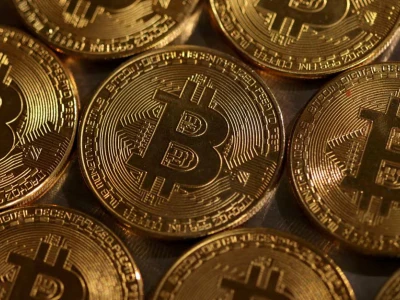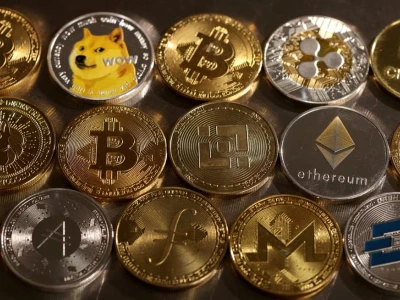
Crypto is dead: long live crypto!
History shows that for privately issued currencies to attain critical mass it has typically required more than just the availability of viable alternatives.
LONDON, June 16 (Reuters Breakingviews) - Already reeling from the “Razzlekhan” scandal, punch-drunk from the collapse of TerraUSD, and floored by the implosion of FTX, cryptocurrencies were finally dealt a knockout blow last week by the U.S. Securities and Exchange Commission. The watchdog brought separate charges against two leading crypto companies, Binance and Coinbase Global(COIN.O), accusing them of operating unlicensed U.S. exchanges for unregistered financial securities and illegally commingling brokerage and clearing.
In truth, the market for digital tokens like bitcoin was already out for the count. Prices have collapsed since the peak of the speculative mania in November 2021. The combined value of cryptocurrencies is down by nearly two-thirds. Trading volumes are less than 10% of their peak.
In retrospect, it is obvious that these electronic securities were the most extreme beneficiaries of the “everything bubble” which propelled the valuations of financial assets with negligible or even non-existent cash flows to astronomical heights. The end of near-zero interest rates, quantitative easing and pandemic-era fiscal stimulus has sent prices crashing back to earth. Rising real interest rates have proved to be kryptonite for crypto, as for so many other speculative assets.
Yet investors should think twice before writing crypto off completely. The normalisation of interest rates may have done for crypto in its most recent incarnation as a get-rich-quick scheme. But it might also be exactly what is needed to resurrect its original sales pitch as the technological breakthrough that would facilitate the global circulation of privately issued currencies capable of transferring economic value across time and space more safely, efficiently and freely than ever before.
That may sound like a tall order. If crypto is to rise once more from the canvas, it will need to extricate itself from the reputational mire of a market structure that SEC Chairman Gary Gensler last week described as “rife with fraud, abuse, and noncompliance”. Digital currencies will also need to convince central bankers that they are not a threat to monetary policy or existing payments systems – something Facebook owner Meta Platforms’ ill-fated Libra project, for example, failed to do.
Yet the underlying structural drivers of crypto’s popularity remain as powerful as ever. In democratic and authoritarian political systems alike, public trust in elites and institutions continues to crumble. Faith in the traditional financial system never recovered from the global crisis of 2008 and has sustained further damage from the recent failure of central banks to foresee inflation and the need for yet another round of taxpayer-funded bailouts. Meanwhile, the digitisation of our daily lives continues at a dazzling pace.
Crypto’s underlying attraction is that it sits squarely at the centre of all these secular trends, offering a seductive vision of how technology can enable citizens to take back political and financial control in the age of digital surveillance. Balaji Srinivasan, author of crypto bible “The Network State”, sums it up: “End the wars. End the Fed. End-to-end encryption.”
It is easy to dismiss such crypto-maximalist manifestos as prime examples of the concept’s crankiness. Nevertheless, they speak to the powerful forces behind the popularity of crypto’s original prospectus as the platform for alternative global currencies. That is something investors should take seriously, especially because neither the idea of private moneys circulating alongside sovereign currency, nor the notion that this might serve a constructive economic role, are remotely novel.
From continent-wide experiments such as the “écu de marc”, which medieval European merchants used to settle international trade, to the humble baby-sitting circle chit popularised by the economist Paul Krugman, through myriad community currencies such as Ithaca hours and the Brixton pound, privately issued moneys have always been a feature of capitalist economies.
Historically, however, two constraints have tended to limit their reach. The first is that, because they lack the backing of the state, their acceptability is limited to users who know and trust one another as partners in some joint commercial or social project. The second is that arranging central private counterparties responsible for issuing, clearing and settling currencies is time-consuming, costly and hard.
Yet modern technology has consigned these obstacles to history. With 5 billion people connected to the internet, communities built around even the most esoteric of interests can now number in the tens of millions. The combination of cryptographic certification and public digital ledgers, meanwhile, means clearing and settlement can be automated and central counterparties eliminated altogether.
The proposition that the circulation of private currencies might be economically beneficial has also been around for a while. Friedrich Hayek’s 1976 book “The Denationalisation of Money” argued that allowing foreign and privately issued moneys to circulate alongside national currencies would improve monetary stability through competitive pressure on central banks. Hayek’s scheme formed the basis for the UK Treasury’s 1989 proposal to launch the euro by first allowing it to circulate alongside existing European currencies. The underlying argument goes back at least as far as the 18th century, when the pioneering Scottish economist James Steuart characterised competition from private money as “the most effective bridle ever was invented against the folly of despotism”.
Nevertheless, history shows that for privately issued currencies to attain critical mass it has typically required more than just the availability of viable alternatives. The official, national currency must also become harder to get.
The golden age of private currencies in the United States came during the Great Depression of the 1930s. With the Federal Reserve persisting with a tight monetary policy, U.S. dollar liquidity dried up. As a result, businesses and households slaked their thirst with privately issued scrip currencies. The sky-high interest rates imposed by the Central Bank of Argentina to stabilise the country’s exchange rate after its January 2002 devaluation had the same effect. By March private currencies made up nearly a third of all the money in the country, taking the place of a peso which had become too expensive to source.
It is precisely when access to official, national currencies becomes prohibitively expensive that privately issued alternatives have historically had a chance to thrive. The Fed and the SEC have joined forces to kill the casino case for crypto, but perhaps its day as the internet of money is yet to come. Crypto is dead. Long live crypto?




